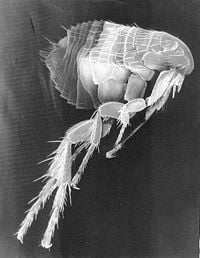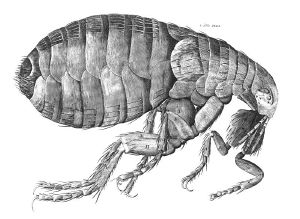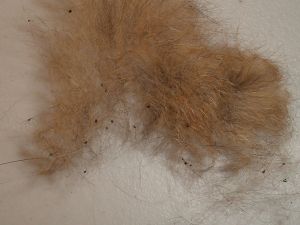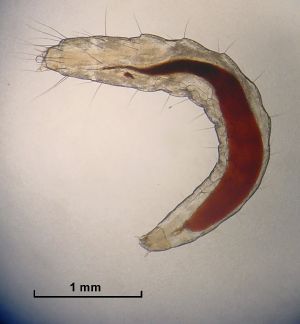Flea
| Fleas | ||||||||||||||||
|---|---|---|---|---|---|---|---|---|---|---|---|---|---|---|---|---|
 SEM of a flea
| ||||||||||||||||
| Scientific classification | ||||||||||||||||
| ||||||||||||||||
|
Tungidae – sticktight and chigoe fleas (chiggers) |
Flea is the common name for any of the small wingless insects of the order Siphonaptera (some authorities use the name Aphaniptera because it is older, but names above family rank do not follow the rules of priority, so most taxonomists use the more familiar name). Fleas are external parasites, living by hematophagy off the blood of mammals and birds, and genetic and morphological evidence indicates that they are descendants of the Scorpionfly family Boreidae, which are also flightless; accordingly it is possible that they will eventually be reclassified as a suborder within the Mecoptera. In the past, however, it was most commonly supposed that fleas had evolved from the flies (Diptera), based on similarities of the larvae.
Note: There is also a genus of foraminiferan Protozoa named Siphonaptera
Some well known flea species include:
- Cat flea (Ctenocephalides felis),
- Dog flea (Ctenocephalides canis),
- Human flea (Pulex irritans),
- Northern rat flea (Nosopsyllus fasciatus),
- Oriental rat flea (Xenopsylla cheopis).
In most cases, fleas are just a nuisance to their hosts, but some people and some animals suffer allergic reactions to flea saliva resulting in rashes. Flea bites generally result in the formation of a slightly-raised swollen itching spot with a single puncture point at the center. The bites often appear in clusters or lines, and can remain itchy and inflamed for up to several weeks afterwards. Fleas can also lead to hair loss as a result of frequent scratching and biting by the animal, and can cause anemia in extreme cases.
However, fleas can also act as a vector for disease. One possible example of this was the bubonic plague, which may have been transmitted between rodents and humans. Murine typhus (endemic typhus) fever, and in some cases tapeworms, Hymenolepis, can also be transmitted by fleas.
Fleas

Fleas pass through a complete life cycle consisting of egg, larva, pupa and adult. Completion of the life cycle from egg to adult varies from two weeks to eight months depending on the temperature, humidity, food, and species. Normally after a blood meal, the female flea lays about 15 to 20 eggs per day — up to 600 in its lifetime — usually on the host (dogs, cats, rats, rabbits, mice, squirrels, chipmunks, raccoons, opossums, foxes, chickens, humans, etc.). Eggs loosely laid in the hair coat drop out almost anywhere, especially where the host rests, sleeps or nests (rugs, carpets, upholstered furniture, cat or dog boxes, kennels, sand boxes, etc.).
Eggs hatch between two days to two weeks into larvae found indoors in and along floor cracks, crevices, along baseboards, under rug edges and in furniture or beds. Outdoor development occurs in sandy gravel soils (moist sand boxes, dirt crawlspace under the house, under shrubs, etc.) where the host may rest or sleep. Sand and gravel are very suitable for larval development which is the reason fleas are erroneously called "sand fleas".
Larvae are blind, avoid light, pass through three larval instars and take a week to several months to develop. Their food consists of digested blood from adult flea feces, dead skin, hair, feathers, and other organic debris; larvae do not suck blood. Pupae mature to adulthood within a silken cocoon woven by the larva to which pet hair, carpet fiber, dust, grass cuttings, and other debris adheres. In about five to fourteen days, adult fleas emerge or may remain resting in the cocoon until the detection of vibration (pet and people movement), pressure (host animal lying down on them), heat, noise, or carbon dioxide (meaning a potential blood source is near). Most fleas overwinter in the larval or pupal stage with survival and growth best during warm, moist winters and spring. "Flea season" is traditionally at the end of summer and in the early fall, but in warmer areas can last year round.
Flea bites can be treated with Calamine lotion or 0.5-1% conc. hydrocortisone cream. Lufenuron is a veterinary medicine that attacks the larval flea's ability to produce chitin. See also Frontline (medicine).
Breaking an infestation
Different people have varying sensitivities to the movement of fleas and to their bites. Some can detect the flea and nab it on the skin; unlucky compatriots only learn of the infestation after a series of rashes erupt the next day. Some people attract fleas while others never learn about them.
If an animal lives in the home, one should treat it monthly with one of the long duration products as recommended by your veterinarian. In general, at least in the United States, one should avoid grocery store or pet shop products which are less effective than the prescription strength products from a licensed veterinarian (or the equivalent in Commonwealth Nations veterinary surgeon). These products will keep the fleas off the pets, not off the owners or out of the furnishings. More drastic measures are required to protect the owners or unlucky non-pet owner with these unwelcome house guests.
To deal with an home infestation one needs to break the life cycle of the fleas and kill off the breeding age individuals which will otherwise produce a new generation within about 10-18 days, so repeat this technique about every two weeks, at least three times.
Area or room treatment
The goal with this method is to create a vapor cloud of a common inexpensive household pest-control (poison) above which the breeding population cannot avoid by jumping. This method uses the ubiquitous anti-moth products available at many retail stores, especially hardware stores (certain) and perhaps grocery stores.
- The best area method would be to place moth crystals (flakes) and moth balls in the infested areas periodically for several hours at a time; this needs to be done thoroughly, placing moth balls about the floor and on couches, beds, and wherever there are fabrics within a foot or so from the floor. In particular, large area items like couches, and beds need to be individually sprinked across more than 50% of their surface area. Moth flakes are more volatile and would be the better product on these furnishings. Exact placement of the material is not necessary (e.g., some flakes fall into cracks), as the vapors spread both outwards and down.
- One should block off the area's (or room's) egress with towels under doors or sheets (bedding or plastic types) taped across the doorways. All ventilation (forced hot air furnaces and air conditioners) should be shut off until after the treatment.
- The area should be vacated by humans and pets and the area allowed to 'soak' for two to three hours.
- Before use, the vacuum cleaner should be cleaned. Then, the vacuum cleaner should be used to vacuum up the flakes or balls and transfer them into a plastic bag or container for reuse for the next treatment in two weeks. Leaving moth balls or flakes under beds in closets, behind dressers, etc. is recommended, as any leftover fleas may be sickened or killed. As the vapors stay low, this should be safe if performed in moderation. Anything that is likely to inhibit the growth of hatchlings will aid the eradication effort.
- This cleaning process should be repeated two to three times, with each cleaning two weeks apart. If the home being treated is in a sub-tropical clime subject to a higher humidity like the American south (say below the Mason-Dixon line), then the number of treatments should be increased up to five or six times overall. If a flea bite occurs anytime afterwards, the treatment process should be performed again.
Whole home treatment
For a particularly widespread infestation, one should follow the above strategy with insecticide bombs. Chain home stores sell four packs at a cheap price compared to singletons purchased from hardware stores. The objective is to kill the immature hatchlings before they mature and lay more eggs. The first downside to this method is that it requires vacating the premises for several hours. However, the main downside to this method is the need to protect foodstuffs; therefore, the user is strongly urged to read all directions carefully. This method is generally practiced in commercial restaurants once or twice monthly, so some due caution is warranted, but managable with appropriate safeguards.
If the home is carpeted throughout, whole home treatment would generally be preferred, as there is no way of knowing where the fleas may be at any moment. However, if the home contains mostly hard flooring, the using mothflakes/mothballs would be the better method, as problem areas that need to be treated can be specifically targeted, although it is possible that some infested areas could be missed with the targeted method.
With the first method, one can leave the barriers in place for a few weeks if necessary, and naturally, the two methods can be used simultaneously.
Individual treatment
Consumption of aged garlic is purported to be a natural flea repellant, as the fleas do not like the different taste of blood it creates. This consumption based prophylatic treatment may take far longer than conventional methods. Un-aged garlic can cause a toxic fatal reaction in some household pets, so caution should be used in choosing the correct product.
Apply Frontline or lufenuron (Program) on pets as directed.
Baking soda mixed with equal amount of salt kills fleas. It is rubbed into a pet's fur, pet's bedding, and the carpet. It can kill adult fleas by irritating their chitinous exoskeletons and causing dessication. Wash/rinse pet after treatment to avoid a skin problem. Do not dust the carpet on a rainy day, as the salt will absorb moisture from the air, causing the carpet to become wet. [1]
While killing live fleas is a noble proposition, the true threat comes from their scattered eggs that resist even machine washing, Those with an energy intensive kitchen can freeze their sheets and clothing to guarantee that the adults and the eggs perish. This has been 100% effective when combined with a cleansing shower.
External links
- Advice about fleas from the Berkeley Parents Network
- Links to flea bite pictures (Hardin MD/Univ of Iowa)
- Good Neighbors An essay on the natural history of the flea
- Ohio State University Fact Sheet Life cycle and control methods for fleas
- Breaking the Flea Cycle
- Sand Flea Bite Picture
Credits
New World Encyclopedia writers and editors rewrote and completed the Wikipedia article in accordance with New World Encyclopedia standards. This article abides by terms of the Creative Commons CC-by-sa 3.0 License (CC-by-sa), which may be used and disseminated with proper attribution. Credit is due under the terms of this license that can reference both the New World Encyclopedia contributors and the selfless volunteer contributors of the Wikimedia Foundation. To cite this article click here for a list of acceptable citing formats.The history of earlier contributions by wikipedians is accessible to researchers here:
The history of this article since it was imported to New World Encyclopedia:
Note: Some restrictions may apply to use of individual images which are separately licensed.

